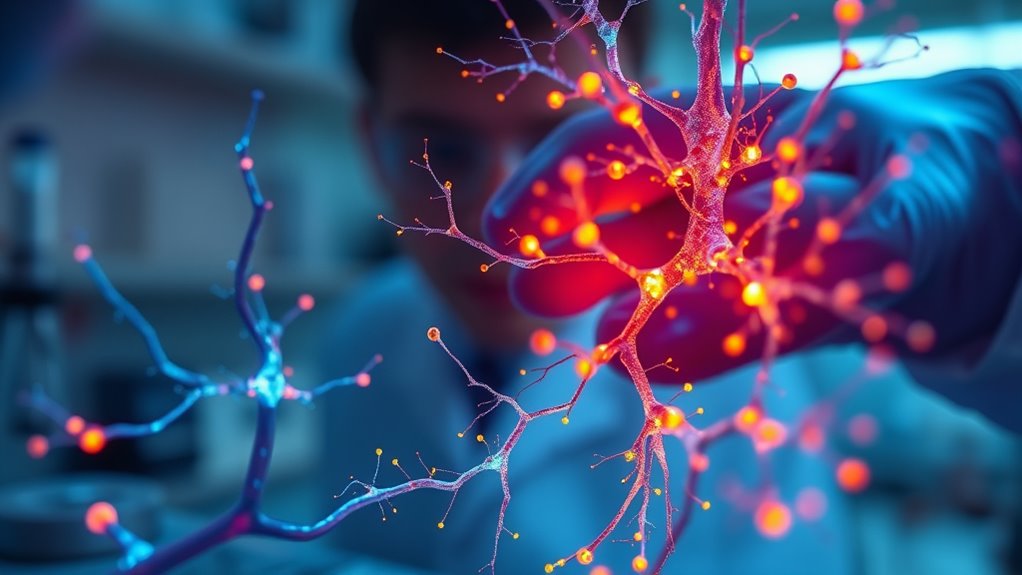Neuroscientists have identified specific brain cells that actively help you forget by removing outdated or unnecessary memories. These cells participate in synaptic pruning, which streamlines your brain’s connections and keeps it adaptable. Their activity guarantees you focus on current information, not old memories that no longer serve you. Understanding these cells reveals how the brain maintains balance between remembering and forgetting, offering fascinating clues about brain flexibility—there’s more to discover about how this process shapes your mind.
Key Takeaways
- Specific neurons actively clear outdated or unnecessary memories through synaptic pruning.
- These “forgetting cells” act as gatekeepers, eliminating weak or irrelevant neural connections.
- Their activity supports neuroplasticity, allowing the brain to adapt by removing obsolete information.
- Activation of these cells during learning helps streamline cognitive functions by removing old memories.
- Understanding these cells offers potential for targeted treatments to manage memory retention and loss.

Scientists have identified specific brain cells responsible for causing us to forget information, shedding new light on the mechanisms behind memory loss. This discovery highlights the role of certain neurons that actively participate in clearing out unnecessary or outdated memories. These cells are involved in a process called synaptic pruning, which is fundamental for maintaining a healthy and efficient brain. During synaptic pruning, the brain eliminates weaker or less-used connections between neurons, allowing the more essential pathways to strengthen. This process is indispensable for neuroplasticity, the brain’s ability to adapt and reorganize itself by forming new connections. While neuroplasticity generally supports learning and recovery, it also involves the removal of redundant or irrelevant information, which can sometimes lead to forgetting.
Certain brain cells actively clear outdated memories through synaptic pruning, supporting neuroplasticity and efficient learning.
As you learn new things or experience different events, your brain constantly adjusts its network of connections. When it determines that certain memories are no longer useful or relevant, it activates these specific brain cells to initiate synaptic pruning. This activity helps streamline your cognitive functions, making it easier to focus on current tasks rather than cluttered or outdated memories. Fundamentally, these cells act as gatekeepers, deciding which connections to retain and which to eliminate, ensuring your brain remains flexible and efficient.
Understanding the role of these forgetting cells sheds new light on how your brain balances memory retention and loss. It’s not just a passive process but an active one driven by specialized neurons that respond to your ongoing experiences and needs. Neuroplasticity, in this scenario, isn’t just about forming new memories; it also involves selectively removing older, less relevant ones to optimize your mental resources. This dynamic process allows your brain to adapt to changing environments and learn new skills more effectively. It also explains why forgetting can sometimes be beneficial—your brain makes room for fresh information by pruning away what isn’t necessary anymore.
In practical terms, this insight could lead to new ways of treating memory-related conditions. If scientists can figure out how to control or influence these specific brain cells, they might develop therapies to slow down unwanted memory loss or enhance memory retention. For now, understanding that forgetting is an active process controlled by specialized neurons gives you a better appreciation of how your brain stays adaptable and efficient throughout your life. It’s a delicate balance, where synaptic pruning and neuroplasticity work together to shape your evolving mental landscape.
Frequently Asked Questions
How Do These Brain Cells Differ From Those Involved in Memory Formation?
You might wonder how these brain cells differ from those involved in memory formation. These cells play a role in the neural mechanisms that cause forgetting, actively disrupting or weakening memory pathways. In contrast, memory-forming cells strengthen connections within these pathways, encoding new information. Fundamentally, forget cells help prune or diminish certain memories, while memory cells build and maintain them, highlighting a dynamic balance in your brain’s memory system.
Can Targeting These Cells Improve Memory Retention in Humans?
You might wonder if targeting these specific brain cells can boost your memory. While neural modulation of these cells shows promise for memory enhancement, research is still in early stages. Currently, studies suggest that precise interventions could improve retention, but it’s not yet proven safe or effective in humans. So, while this approach could one day help you remember better, more research is needed before it becomes a practical solution.
Are There Any Known Conditions Linked to Malfunction of These Forget-Inducing Cells?
You should know that malfunctions in these forget-inducing cells are linked to various conditions. For example, in neurodegenerative diseases like Alzheimer’s, abnormal activity can cause memory issues. Psychiatric disorders, such as PTSD, may involve these cells overacting, leading to excessive forgetting or difficulty retaining memories. Understanding these connections helps scientists develop targeted treatments, potentially improving memory function and reducing symptoms in affected individuals.
How Quickly Can These Cells Influence the Process of Forgetting?
Think of your memory as a dance floor, where forget-inducing cells are the DJs changing the tune. These cells influence forgetting rapidly, within moments, by altering synaptic plasticity and neurotransmitter dynamics. As soon as they activate, they can weaken connections that hold memories, making them fade quickly. Their swift action helps your brain stay adaptable, yet it also means forgetting can happen almost instantaneously when these cells take over.
Do These Cells Play a Role in Emotional or Traumatic Memory Suppression?
You might wonder if these cells are involved in emotional suppression or traumatic memory. Evidence suggests they could play a role by actively helping your brain filter or weaken distressing memories, making it easier to cope. These cells might assist in dampening emotional responses, offering relief from traumatic memories. Understanding this could lead to better treatments for emotional and traumatic memory regulation, helping you manage difficult experiences more effectively.
Conclusion
As you navigate your memories, remember that these brain cells are like the gatekeepers of your past—holding the keys to what you remember and forget. Their role symbolizes the delicate balance between holding on and letting go, shaping your identity with each choice to recall or release. Understanding these cells offers you a glimpse into the mystery of memory itself, reminding you that sometimes, forgetting is just as essential as remembering in the story of who you are.









